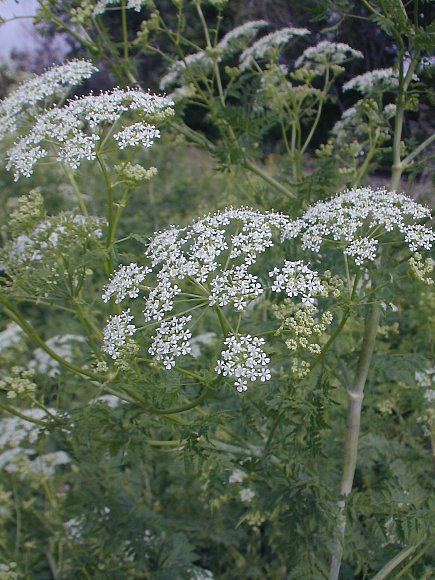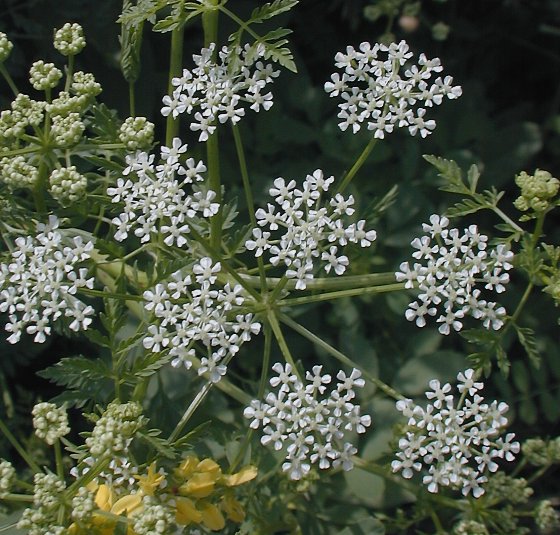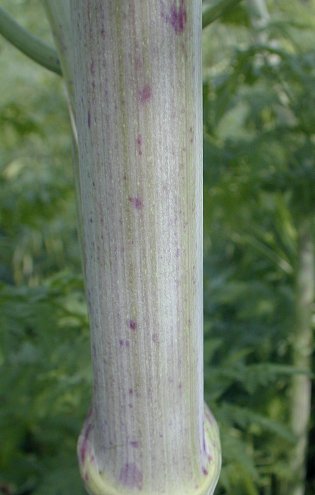Description: This is a biennial plant. During the 1st year, it consists of a rosette of basal leaves spanning about ¾–1½' across. During the 2nd year, it produces a flowering stalk that becomes 3-7' tall, branching occasionally above. The stems are round, glabrous, light green, and purple-spotted; they often appear to be ribbed because of longitudinal veins. The alternate leaves are up to 18" long and 12" across, becoming smaller as they ascend the stems. They are double or triple pinnately compound, triangular-ovate in outline, and hairless. These leaves have a fern-like appearance and a somewhat filmy upper surface. The basal and lower leaves have long petioles, while the upper leaves have shorter petioles. The base of each petiole is partially covered by a sheath. The ultimate leaflets of the compound leaves are about 1/3" (8 mm.) long, lanceolate to ovate in shape, pinnately cleft or dentate, and hairless.

The upper stems terminate in compound umbels of small white flowers. These compound umbels span about 2-5" across and consist of about 8-16 umbellets. Each umbellet consists of about 12-25 flowers. Individual flowers span only 1/8" (3 mm.) across when they are fully open. Each flower has 5 white obcordate petals, 5 spreading white stamens, and a white nectar pad in the center. At the base of the compound umbel are several floral bracts that are ovate-lanceolate with elongated tips; there are also several bractlets at the base of each umbel. These bractlets are ovate-lanceolate like the bracts, but smaller in size. The blooming period occurs from late spring to mid-summer and lasts about 1-2 months. Each flower is replaced by a schizocarp that is broadly ovate and somewhat flattened; it has several longitudinal ribs that are wavy. The root system consists of a white taproot. This plant spreads by reseeding itself; it often forms colonies at favorable sites.

Cultivation:
The
preference is full sun to light shade, moist conditions, and a fertile
loamy soil. Most vegetative growth occurs during the spring. After
blooming and developing seeds, the foliage turns yellow and withers
away later in the summer. In removing this plant from a given area,
don't pull it out using your bare hands. It is better to wear washable
gloves while hand-pulling a limited number of plants. For large areas
of infestation, it is best to apply broadleaf herbicides or mow down
the plants during the spring shortly before they develop flowers.
Range & Habitat:
Poison Hemlock is a common plant that occurs in many areas of Illinois,
except for scattered counties in north and south (see Distribution
Map). This plant is undoubtedly more common than official
records
indicate and it is still spreading to new areas of the state. Poison
Hemlock is native to Europe and the Middle East, and it was introduced
into North America either accidentally or deliberately.

Habitats
include edges of degraded wetlands and prairies, low-lying areas along
small rivers, banks of drainage ditches, thickets, woodland borders,
fence rows, low-lying areas along railroads and roads, pastures, and
abandoned fields. This plant is usually found in disturbed areas, but
it occasionally invades native habitats.
Faunal Associations:
The nectar of the flowers attracts a wide variety of flies, beetles,
sawflies, and wasps, including Ichneumonid and other parasitoid wasps.
Caterpillars of the butterfly, Papilio polyxenes asterius
(Eastern Black Swallowtail), feed on the foliage, notwithstanding its
extreme
toxicity (personal observation). This toxicity is the result of the
alkaloid
coniine and other chemicals, which can be found in all parts of Poison
Hemlock, including the seeds and roots. Another insect, Orthops scutellatus
(Carrot Plant Bug), eats the seeds of this plant and other members of
the Carrot family (Knight, 1941). Poison Hemlock is also a summer host
plant of several aphids, including Dysaphis
apiifolia (Hawthorn-Parsley Aphid), Hyadaphis foeniculi
(Fennel Aphid), and Hyadaphis
passerinii (Honeysuckle Aphid); see Blackman &
Eastop (2013). Mammalian herbivores won't
touch the foliage because of its bitter rank odor and extreme toxicity.
Just a
small portion of the ingested plant can be fatal to humans.

Comments: The ancient Athenians used the juices of this plant to execute their prisoners, including Socrates during 399 B.C. Death is caused by respiratory arrest and heart failure. Poison Hemlock is a tall and imposing plant that appears to be increasingly common. Many people walk past this species without even realizing what it is. Because there are many members of the Carrot family with small white flowers, it can be somewhat difficult to correctly identify this plant. Poison Hemlock has the following key features: 1) it is often tall-growing, 1) the foliage is at least double pinnate and fern-like in appearance, 2) the foliage has a bitter rank odor, especially when it is bruised, 3) the hairless stems have purple spots, 4) there are undivided bracts at the base of the compound umbel and undivided bractlets at the base of the umbellets, and 5) the small leaflets are pinnately cleft or dentate. Other members of the Carrot family lack one or more of these key features.